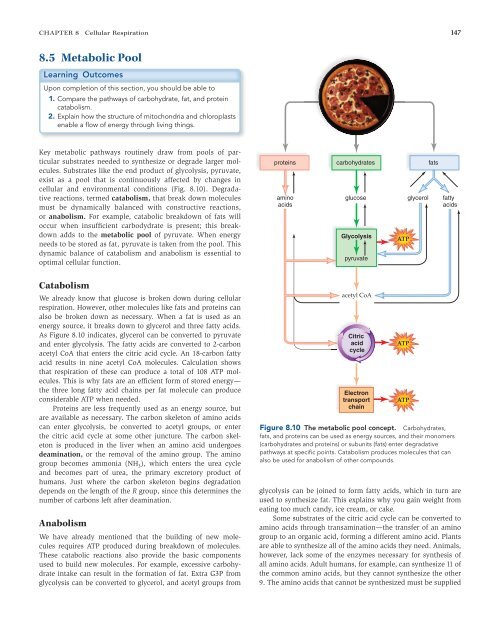Cellular Respiration
Cellular Respiration
Cellular Respiration
You also want an ePaper? Increase the reach of your titles
YUMPU automatically turns print PDFs into web optimized ePapers that Google loves.
CHAPTER 8 <strong>Cellular</strong> <strong>Respiration</strong> 147<br />
8.5 Metabolic Pool<br />
Learning Outcomes<br />
Upon completion of this section, you should be able to<br />
1. Compare the pathways of carbohydrate, fat, and protein<br />
catabolism.<br />
2. Explain how the structure of mitochondria and chloroplasts<br />
enable a fl ow of energy through living things.<br />
Key metabolic pathways routinely draw from pools of particular<br />
substrates needed to synthesize or degrade larger molecules.<br />
Substrates like the end product of glycolysis, pyruvate,<br />
exist as a pool that is continuously affected by changes in<br />
cellular and environmental conditions (Fig. 8.10). Degradative<br />
reactions, termed catabolism, that break down molecules<br />
must be dynamically balanced with constructive reactions,<br />
or anabolism. For example, catabolic breakdown of fats will<br />
occur when insuffi cient carbodydrate is present; this breakdown<br />
adds to the metabolic pool of pyruvate. When energy<br />
needs to be stored as fat, pyruvate is taken from the pool. This<br />
dynamic balance of catabolism and anabolism is essential to<br />
optimal cellular function.<br />
Catabolism<br />
We already know that glucose is broken down during cellular<br />
respiration. However, other molecules like fats and proteins can<br />
also be broken down as necessary. When a fat is used as an<br />
energy source, it breaks down to glycerol and three fatty acids.<br />
As Figure 8.10 indicates, glycerol can be converted to pyruvate<br />
and enter glycolysis. The fatty acids are converted to 2-carbon<br />
acetyl CoA that enters the citric acid cycle. An 18-carbon fatty<br />
acid results in nine acetyl CoA molecules. Calculation shows<br />
that respiration of these can produce a total of 108 ATP molecules.<br />
This is why fats are an effi cient form of stored energy—<br />
the three long fatty acid chains per fat molecule can produce<br />
considerable ATP when needed.<br />
Proteins are less frequently used as an energy source, but<br />
are available as necessary. The carbon skeleton of amino acids<br />
can enter glycolysis, be converted to acetyl groups, or enter<br />
the citric acid cycle at some other juncture. The carbon skeleton<br />
is produced in the liver when an amino acid undergoes<br />
deamination , or the removal of the amino group. The amino<br />
group becomes ammonia (NH 3 ), which enters the urea cycle<br />
and becomes part of urea, the primary excretory product of<br />
humans. Just where the carbon skeleton begins degradation<br />
depends on the length of the R group, since this determines the<br />
number of carbons left after deamination.<br />
Anabolism<br />
We have already mentioned that the building of new molecules<br />
requires ATP produced during breakdown of molecules.<br />
These catabolic reactions also provide the basic components<br />
used to build new molecules. For example, excessive carbohydrate<br />
intake can result in the formation of fat. Extra G3P from<br />
glycolysis can be converted to glycerol, and acetyl groups from<br />
proteins carbohydrates fats<br />
amino<br />
acids<br />
glucose glycerol fatty<br />
acids<br />
Glycolysis<br />
pyruvate<br />
acetyl CoA<br />
Citric<br />
acid<br />
cycle<br />
Electron<br />
transport<br />
chain<br />
ATP<br />
ATP<br />
ATP<br />
Figure 8.10 The metabolic pool concept. Carbohydrates,<br />
fats, and proteins can be used as energy sources, and their monomers<br />
(carbohydrates and proteins) or subunits (fats) enter degradative<br />
pathways at specific points. Catabolism produces molecules that can<br />
also be used for anabolism of other compounds.<br />
glycolysis can be joined to form fatty acids, which in turn are<br />
used to synthesize fat. This explains why you gain weight from<br />
eating too much candy, ice cream, or cake.<br />
Some substrates of the citric acid cycle can be converted to<br />
amino acids through transamination—the transfer of an amino<br />
group to an organic acid, forming a different amino acid. Plants<br />
are able to synthesize all of the amino acids they need. Animals,<br />
however, lack some of the enzymes necessary for synthesis of<br />
all amino acids. Adult humans, for example, can synthesize 11 of<br />
the common amino acids, but they cannot synthesize the other<br />
9. The amino acids that cannot be synthesized must be supplied

















